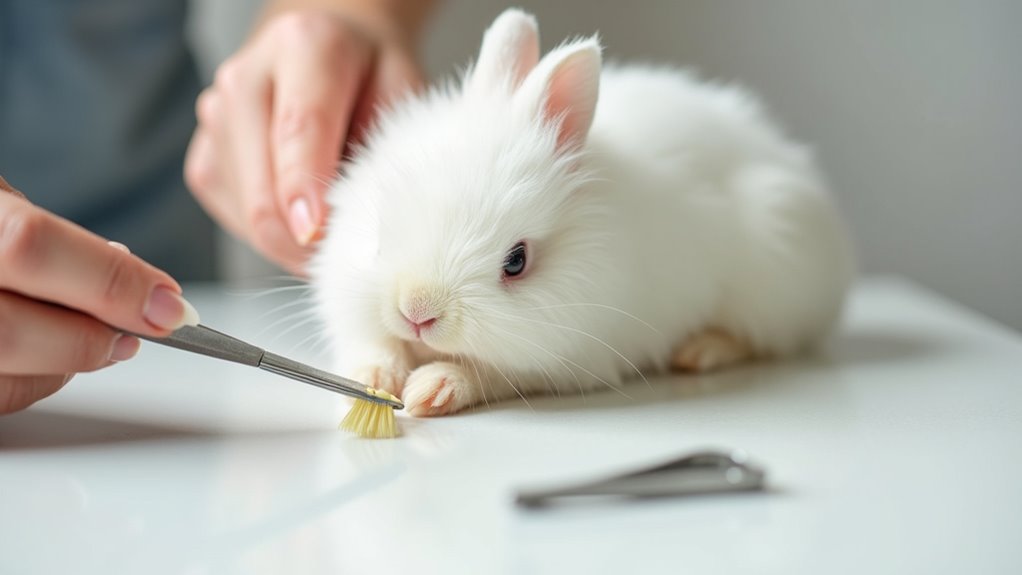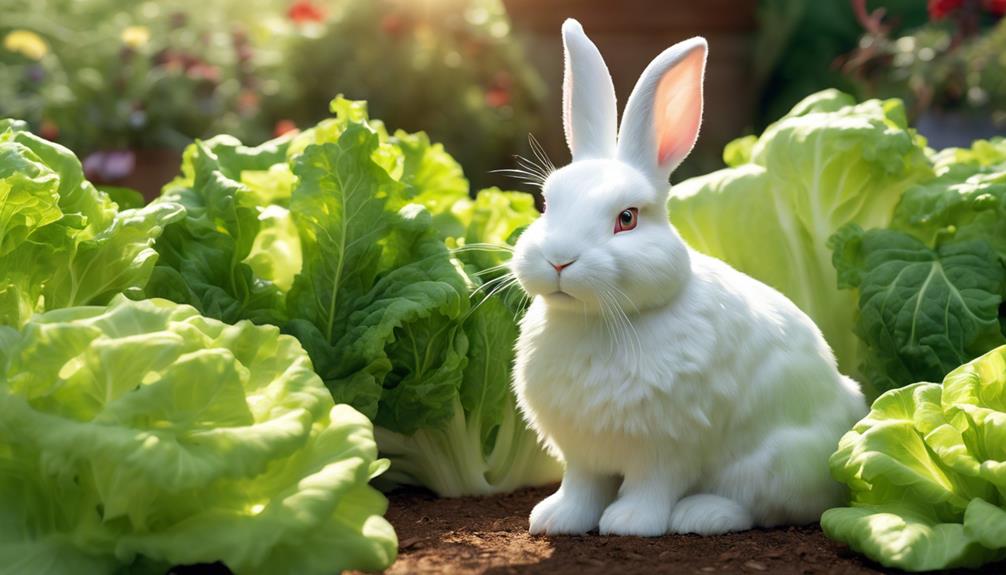To groom your rabbit safely, start by gently brushing its fur with a soft-bristled or slicker brush, working from the head down and avoiding sensitive areas. Trim nails using small, sharp clippers in a calm environment, being careful not to cut into the quick. Use gentle handling and take breaks to reduce stress. Doing this regularly keeps your rabbit comfortable and healthy—stay tuned to learn more tips for stress-free grooming.
Key Takeaways
- Use gentle, soft-bristled brushes and start brushing from the head down, especially around sensitive areas.
- Trim nails in a calm environment, avoiding the quick, and offer treats to reduce stress.
- Regular grooming prevents matting, reduces shedding, and allows for health checks.
- Handle your rabbit gently with proper techniques to build trust and minimize anxiety.
- Patience and consistent routines ensure safe, positive grooming experiences for your rabbit.

Grooming your rabbit is an essential part of keeping it healthy and happy. Regular grooming helps prevent matting, reduces shedding, and keeps your rabbit comfortable. It also provides an opportunity to check for any health issues, such as skin infections or parasites. One important aspect of grooming is managing the rabbit allergen, as rabbits can produce proteins in their fur and saliva that trigger allergic reactions in sensitive individuals. By grooming your rabbit regularly, you can minimize loose fur and dander, which helps reduce allergen levels in your home. To do this effectively, you’ll need the right grooming tools. A gentle brush designed for rabbits, such as a soft-bristled or slicker brush, can help remove loose fur without irritating the skin. Using appropriate grooming tools not only makes the process smoother but also less stressful for your rabbit. When brushing, start at the head and work your way down the body, being gentle around sensitive areas like the belly and behind the ears. Regular brushing prevents fur from matting and reduces hair ingestion during self-grooming, which can lead to digestive issues. It’s best to establish a routine—perhaps a few times a week—so your rabbit gets used to the process and it becomes less stressful over time. Additionally, understanding the importance of hamster care costs can help you plan for veterinary visits and grooming supplies. Recognizing the significance of professional grooming techniques can also ensure your rabbit’s safety and comfort during grooming sessions. Incorporating proper handling techniques can further reduce stress and promote a positive grooming experience. Trimming your rabbit’s nails is another fundamental grooming task that should never be overlooked. Overgrown nails can cause discomfort, pain, or even lead to sores if they catch on fabric or cage bars. Before trimming, choose a quiet, calm environment to keep your rabbit relaxed. Use a pair of small, sharp nail clippers designed for small animals, and be cautious not to cut into the quick, the sensitive area inside the nail that contains blood vessels. If you’re unsure, it’s better to trim just a little at a time rather than risk causing pain or bleeding. If your rabbit struggles or becomes anxious during nail trimming, take breaks and offer treats or gentle praise to build trust. Regular trims, approximately every 4-6 weeks, help keep the nails at a healthy length and prevent long-term issues. Combining consistent grooming with gentle handling also strengthens your bond and makes future grooming sessions easier. Remember, patience and gentle techniques are key. Overall, grooming your rabbit isn’t just about appearance; it’s about maintaining its health and well-being. With the right grooming tools and a calm approach, you’ll make grooming a positive experience for both you and your furry friend.
Frequently Asked Questions
How Often Should I Brush My Rabbit’S Fur?
You should brush your rabbit’s fur at least once a week to prevent matting and reduce shedding. Regular grooming also helps you spot any issues early, especially if their diet isn’t providing enough nutrients for healthy coat growth. Keep up with veterinary visits to guarantee overall health, and adjust grooming frequency if your rabbit has long hair or tends to shed more. Consistent care keeps your bunny happy and comfortable.
What Type of Brush Is Best for Rabbits?
When choosing the best type of brush for your rabbit, it’s important to think about your pet’s fur type. You should look for recommended brushes designed specifically for rabbits, such as soft-bristled or slicker brushes, which are gentle and effective. These rabbit grooming tools help prevent mats and reduce shedding. Always select a brush that suits your rabbit’s coat length and texture to make grooming safe and comfortable.
How Do I Prevent My Rabbit From Scratching During Grooming?
To prevent your rabbit from scratching during grooming, guarantee gentle handling and create a calm environment. Use soft, reassuring words to keep your rabbit relaxed. When trimming claws, do it carefully to avoid pain or injury, which can cause scratching. Regular claw trimming helps reduce scratching incidents, and offering treats afterward encourages positive associations. Patience and calmness are key to scratch prevention and making grooming a safe, stress-free experience for both of you.
Can I Trim My Rabbit’S Nails With Household Scissors?
Trying to trim your rabbit’s nails with household scissors is like using a sledgehammer for a delicate task. Household scissors aren’t designed for nail trimming and can cause injury or splinter the nails. Instead, use proper rabbit nail trimmers for safe, controlled nail trimming. This guarantees your bunny stays comfy and avoids accidental cuts. Always be gentle and focus on trimming just the tip to keep your rabbit happy and healthy.
What Signs Indicate My Rabbit Needs Professional Grooming?
You notice your rabbit shows signs of discomfort, such as difficulty eating or missing fur patches, which indicate they need professional grooming. Pay attention to rabbit dental health issues like overgrown teeth or drooling. If you’re unsure, consult a professional groomer who uses suitable grooming products and can check for underlying problems. Regular grooming helps prevent discomfort and makes sure your rabbit stays healthy and happy.
Conclusion
Grooming your rabbit gently nurtures trust and keeps your furry friend feeling their best. With patience and care, you create a peaceful dance of trust and tenderness. Remember, every gentle stroke and careful trim weaves a quiet bond that blossoms over time. As you continue this tender routine, your bunny will feel more loved and comforted, turning grooming into a cherished moment you both look forward to—making every day a little brighter for your little companion.










